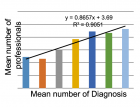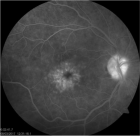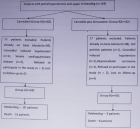About University of Khartoum
University of Khartoum
Articles by University of Khartoum
Investigation on Theileria lestoquardi infection among sheep and goats in Nyala, South Darfur State, Sudan
Published on: 6th September, 2017
OCLC Number/Unique Identifier: 7325431938
This study was conducted in Nyala, South Darfur State, Sudan during August-September 2015 to study the seroprevalence of ovine and caprine theileriosis and to identify the tick infesting sheep and goats. For this purpose, total of 150 samples (ticks, blood smear and sera) were collected from sheep (n=61) and goats (n=89) of different age groups, breed and both sex. Three age groups were included: less than one-year-old, one-two years-old and more than two-year-old. Two diagnostic techniques were used, blood smears, and indirect fluorescent antibody test (IFAT). Out of 150 samples, 9 (6%) were positive for Theileria spp. piroplasms in blood smears, and 81 (54%) were positive for Theileria lestoquardi antibodies. Out of 61 sheep, 3 (4.9%) were positive for Theileria spp. piroplasms, and 25 (41%) were positive for T. lestoquardi antibodies. Out of 89 goats, 6 (6.7%) were positive for Theileria spp. piroplasms, and 56 (62.9%) were positive for T. lestoquardi antibodies. The highest prevalence of T. lestoquardi was recorded among sheep and goats more than two-year-old. Two genera and 4 species of ticks were infested sheep and goats. These included Rhipicephalus evertsi evertsi, R. s. sanguineus, Amblyomma variegatum and A. lepidum. The study concluded that the malignant ovine theileriosis is endemic in Nyala town.
Diagnosis of Asthma in Childhood Age
Published on: 13th September, 2018
OCLC Number/Unique Identifier: 7878010008
Background: Asthma is the most common chronic respiratory disorder in childhood. Asthmatic attacks are described and classified according to the type of wheezing to Non –atopic and Atopic asthma (IgE mediated wheezing). The aim of this review is to determine the onset of clinical diagnosis in relation to clinical presentation of asthma in children and obstacles related to delay of Asthma diagnosis.
Methods: This review highlights the results of studies done regarding clinical diagnosis in relation to clinical presentation and of asthma in children. An extensive search has been conducted for researches about asthma in children. This search based on the publications posted on the National Center for Biotechnology Information PubMed or by Google Scholar. Key words used for the research: Asthma, clinical diagnosis, children.
Results and Conclusion: Diagnosing asthma in young children is difficult because children often cough and wheeze with colds and chest infections, but this is not necessarily asthma. Miss diagnosis of asthma in children occurs when physicians diagnose patients with asthma from the clinical diagnosis in the first attack without excluding other asthma mimickers which can be any other respiratory problem. There is over-diagnosis of asthma due to the symptoms which mimic other respiratory infections. First episodes of cough, runny nose and fever that happen in cold/flu season- fall/winter/early spring is likely not asthma. If the child has several more episodes of wheeze and cough, it is likely to be asthma. Since there is no diagnostic test available for children younger than 6 years of age, making a diagnosis in this age group is more difficult than in older children. Over the age of about 6 years it is possible for a child to have a spirometer test
Serological and virological profile of patients with chronic hepatitis B infection in Eritrea
Published on: 24th July, 2020
OCLC Number/Unique Identifier: 8639906724
Background: Hepatitis B virus infection is a major cause of liver associated morbidity and mortality with diverse spectrum of disease. It is estimated about 15% to 40% of patients with hepatitis B virus infection progress to chronic hepatitis and about 15% to 25% die from disease complications. The main aim of this study was to evaluate the serological and virological markers of patients with chronic hepatitis B virus infection to determine the natural history of chronic hepatitis B infection in the Eritrean setting.
Methods: A laboratory-based cross-sectional study was conducted on 305 patients with HBsAg positive who presented to Orotta National Referral Hospital, Halibet Hospital, Sembel Hospital and National Health Laboratory in Asmara, Eritrea from January 2017 to February 2019. Enzyme-linked immunosorbent assay was performed to detect hepatitis B serological markers (anti-HBc, HBsAg, anti-HBsAb, HBeAg and anti-HBeAg). Hepatitis B DNA viral loads and liver transaminase levels were determined. Data analysis was conducted using SPSS version 25.0.
Results: A total of 305 patients presented with HBsAg positive serology with a mean age of 41.3 (± 13.7) years ranging from 16 to 78 years. Males were 218 (71.5%) and females 87 (28. 5%).Anti-HBc was positive in 300 (98.4%), of which 293 (97.5%) were positive for HBsAg and 7 (2.3%) positive for anti-HBs. Among these 293 patients, 20 (6.8%) were HBeAg positive/anti-HBe positive, 242 (82.6%) HBeAg-negative/anti-HBe-positive and 31 (10.6%) were HBeAg negative/anti-HBe-positive. Detectable HBV DNA was found in 122(41.6%) of the 293 cases. Alanine transaminase was normal in 90% of HBeAg-positive and in 91.2% of HBeAg-negative patients. Hepatitis B DNA viral load was >2,000 IU/mL in 67 (22.86%) and >200,000 IU/mL level was more frequently detected in HBeAg positive (20.0%) compared to HBeAg negative (1.8%) subjects (p < 0.001).
Conclusion: This study shows predominance of HBeAg-negative and low replication phase of HBV infection among patients in Eritrea. It also documented that most patients had chronic infection with normal liver transaminase levels in the absence of biochemical signs of hepatitis. This study will provide a basis for therapeutic evaluation of patients and planning national treatment guidelines in the Eritrean setting.
Satellite-Based Analysis of Air Pollution Trends in Khartoum before and After the Conflict
Published on: 16th January, 2025
This study investigates the impact of socio-political disruptions on air quality in Khartoum, Sudan, focusing on key pollutants: Aerosol Optical Depth (AOD), Carbon Monoxide (CO), Nitrogen Dioxide (NO₂), and Sulfur Dioxide (SO₂). Using Sentinel-5P satellite data (2020–2024) processed in Google Earth Engine (GEE), spatial and temporal variations in pollutant levels were analyzed before and after a significant war event in April 2023. The methodology included data acquisition, preprocessing (e.g., cloud masking, spatial filtering), monthly averages computation, visualization, and statistical analysis using Google Earth Engine (GEE), ArcGIS Pro, and Microsoft Excel. Results showed a marked post-war increase in AOD levels, attributed to infrastructure destruction, fires, and diminished industrial oversight, alongside spatially consistent pollution patterns in some regions. CO concentrations exhibited an overall decline due to reduced industrial activities and transportation, though localized anomalies were linked to concentrated emissions. Similarly, NO₂ levels dropped significantly, reflecting reduced vehicular and industrial activities, while sporadic increases suggested localized emissions like generator use. SO₂ demonstrated mixed trends, with reduced mean levels but increased variability, indicating sporadic high-emission events linked to emergency fuel use or conflict-related disruptions. This study uniquely combines high-resolution satellite data with advanced spatial and temporal analysis techniques to reveal the nuanced and multi-pollutant impact of socio-political conflicts on air quality in Khartoum, providing novel insights into the environmental repercussions of armed conflicts. These findings highlight the profound impact of socio-political events on atmospheric pollution dynamics, underscoring the need for robust urban planning, targeted environmental monitoring, and policies to mitigate air quality deterioration and address public health concerns in conflict-prone regions. The study emphasizes the importance of satellite-based monitoring to provide critical insights into the environmental repercussions of socio-political upheavals.

If you are already a member of our network and need to keep track of any developments regarding a question you have already submitted, click "take me to my Query."



















































































































































